Baja California, Mexico and San Diego 2014/2015
After almost exactly 2 years on land (in Indonesia and England) we stepped on board our new home, and once again became
boat owners and ocean travellers - with all the freedom, responsibility and financial precariousness that this entails.
Two things were surprising - firstly, how easy it was to slip back into most aspects of boat living; but on the other hand,
how we had actually gotten used to many of the comforts and conveniences of landlife.
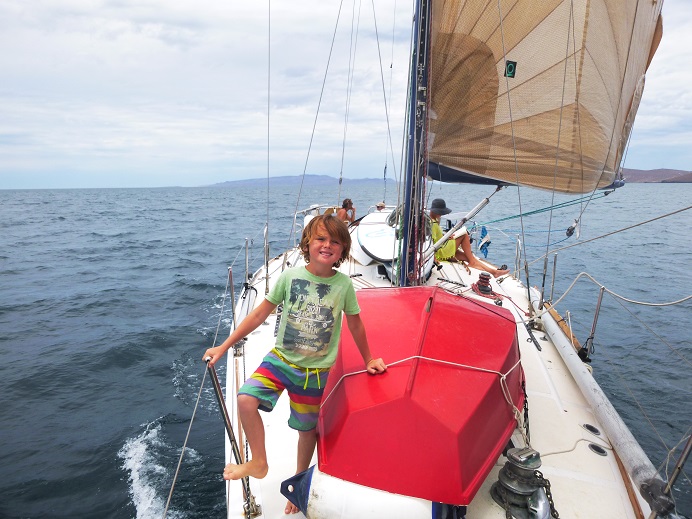
Jayden
While in England, I could order my shopping online and have it delivered to my door. In San Diego I had to balance the family's
food shopping on the back of a tiny fold up bicycle, cycle back through town to the dock, and then dinghy it back to the boat.
A much lengthier process, and one that needed repeating every couple of days due to the limited amount of room on the bike.
But we quickly readjusted and began the process of readying our new vessel 'Sangvind' (named by the first owners and meaning Windsong in Swedish)
for the ocean. She had been in the marina for several years and used for racing rather than cruising, so there were several modifications we wanted
to undertake to equip her for live aboard cruising and ocean sailing.

Jayden's first windsurfing lesson
It was an easy transition back into the social world of the cruising community, with various dinners, drinks and other get togethers, and it was nice to meet
with the Swiss boat Celuann as we had sailed in many of the same countries and had several mutual friends. The sailing world is a small one
and it doesn't take long to meet people who know people you know.

Jimmy and Pedro sailing with us in the Sea of Cortez
'Sangvind' is really a joy to sail. She picks up speed quickly in a light breeze and comfortably cruises at 7 or 8 knots. We sailed overnight to
Ensenada, our first Mexican port, and of course the first thing we wanted to do was go out for food! I love the typical Baja speciality of fish tacos
- some grilled fish, soft round tacos, and then a help yourself selection of fresh salsas, salads, guacamole and sauces, coupled with the ubiquitous chilli
and lime. Fresh, simple and delicious. I could happily eat it every day.
We then spent 5 nights sailing to La Paz, a lovely town which is known for the whale sharks that feed in the outer bay, and also being in the Guiness
Book of World Records for creating the longest ever Burrito - at 3km long! We took the dinghy to see the whale sharks, which was an amzing experience.
They are huge and very graceful. 'Gentle giants', they are often called. We swam alongside a young shark, about 20ft long, who was going about his business,
completely unconcerned by our presence in the water. It was a little bit intimidating, because while you know that they are only eating krill and plankton,
they still have a body that looks very shark like and instinctively that seems unsettling. Jayden let out a little scream, out of fear or excitement, I'm not
sure which!
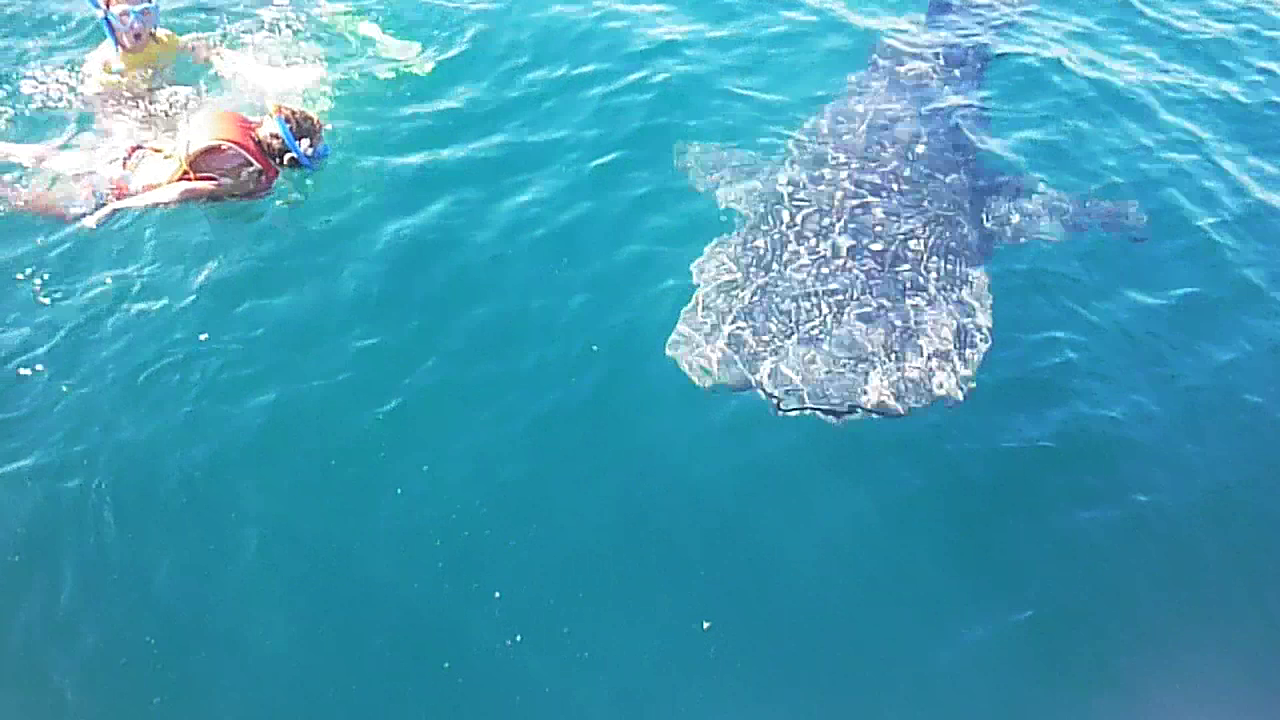
Jayden and Dylan swimming beside a whale shark
The Baja is very dry - we have not yet had any rain here these past 3 months - and the land is desert like, dusty, barren and hot. Cactus plants thrive, and
I'm told the limited vegetation here is fertilised primarily from the sea birds - which are plentiful. Frigates, pelicans, blue footed boobies, the bird life
and marine life in the Sea of Cortez is abundant, in contrast to the dry empty landscape.

A rare bit of green in the Baja
Jimmy, Heather, Pedro and Xochitl joined us in the Sea of Cortez to explore some of the islands and bays. We paddleboarded through mangrove lagoons,
and everyone had a few windsurf lessons from Pedro. We caught fish, and discovered long deserted beaches. We snorkelled over coral and rocky
outcrops, and had several social evenings with other boats. It was a fun filled and action packed couple of weeks.

Xochitl found a fish skeleton washed up on shore
Frans windsurfing in Candeleros, Baja from oceannomads on Vimeo.
Hurricane season started early with Blanca predicted to make landfall near La Paz in early June. After the
devastation that Odile caused the previous year there was a lot of concern and speculation about
Blanca. We decided to tie up in a marina rather than sit it out at anchor. There are a lot of
unattended boats in La Paz that you don't want breaking free and bearing down on you in heavy
weather. The Mexican government operates the Fonatur marinas, and at $20 a night with wifi, showers, laundry and small
swimming pool they are well worth it; it was like a gathering of friends as we all settled in to
a few nights on the dock, organsing a little 'pre-hurricane' bbq by the pool with Resolute, Orion
and Azul. But fortunately Blanca did not hit big, the wind speeds maxed out at just less than 50
knots, and while it sounded a little exciting listening to the wind in the rigging for a while, the kids were a little disappointed (but
relieved too I think) that the 'hurricane' was not more impressive. We had a lot of dust to clean off
the deck afterwards but that was about it.

Pool bbq in La Paz
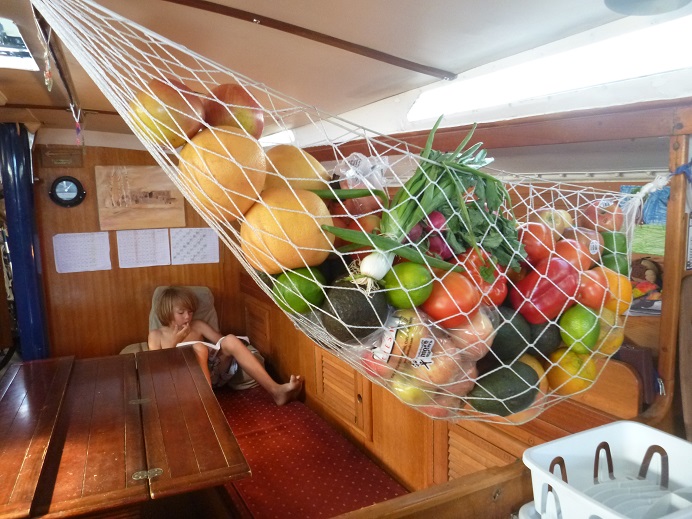
Fresh veggies from Mexico's markets
We were ready to leave La Paz by mid-June, and with a nice southerly breeze slowly cruised our way north, where the chances
of hurricanes diminishes. Along with friends on Orion and Resolute we spent lazy days snorkelling,
paddleboarding, windsurfing, hiking and making beach fires as we hopped up the bays in the Sea of Cortez.
I had not many expectations of Mexico before we arrived, and I was not overly excited by the
photos I had seen of a seemingly endless dry barren landscape. But it worked its charm on me pretty quickly.
The wild open spaces and quietness have an eternal quality that is hard to find in the modern world.
After the hecticness that is San Diego I was so happy to be surrounded by pure nature, a whole peninsula of
1000 miles barely touched by humans. And what seems barren from afar is full of life, bursting
forward in every corner - insects, birds, fish, seals, dolphins, whales, tough hardy flowers, grasses and cacti.
The Baja worked its spell on all of us, and I began to see why many cruisers never leave.

A calm anchorage in the Sea of Cortez
As the summer in the sea grew progressively hotter, and the days and nights were over 100 degrees fahrenheit, we took
to the coolness of the hills in a campervan we borrowed from a friend back in the UK. One thing I
love about the cruising community is the generosity and trustfulness of the people. We met an
English solo sailor in La Paz, and after sharing stories and a few beers one afternoon he offered us the use of his
campervan. 'It's too hot in the Sea over the summer' he said, 'And the van would be ideal
for your family. Take it into the mountains where it's cooler.' He showed us a picture of an old
school Dodge Ram van - perfect and just our style!

Cool mountain air!
Dylan downhill cycling in the Copper Canyon from oceannomads on Vimeo.
So we took off for the refuge and cool air of the Sierra Madre range and the Copper Canyon. The diversity
of the scenery in Mexico is spectacular. After a cactus filled desert we entered worlds of pine forests, rocky mountain towns,
canyons with fast flowing rivers and towering waterfalls, and then further south into the tropical zones of palm-clad beaches.
We visited some beautiful old towns and even older Mayan sites, and stopped by the renowned guitar
making town of Paracho where Frans had bought a handmade guitar 20 years ago.

Guitar maker in Paracho

Ancient pyramid
But then it was soon time to get back to the boatyard and to get some projects done. Happily, the temperature had dropped
to the mid-90's by September, so at least we felt we were able to breathe again. I no longer needed to
take an iced water bottle into bed at night.
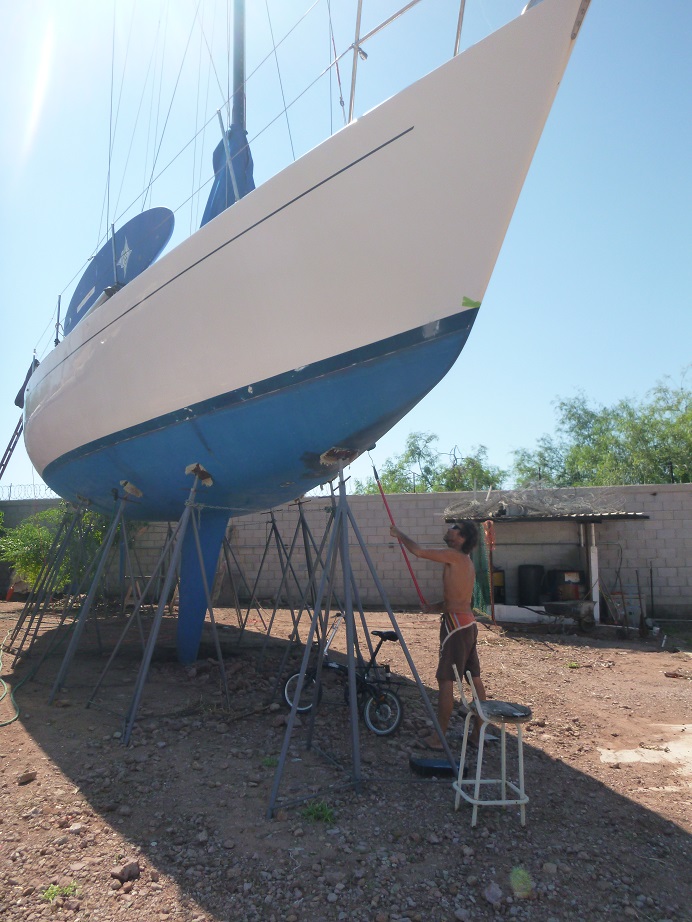
Bottom painting at the boatyard
In November we were ready to cruise again, and for the sail south we were joined by Zach, Randy and Fred as
we island hopped our way down to La Paz. Our first overnight sail was disconcertingly on Friday 13th, surrounded by
lightning storms. We breezed through them with thunder all around but never overhead, making an easy 8 knots,
and covered the 100 miles in record time and arrived in beautiful San Juanico bay just as the sun was rising.
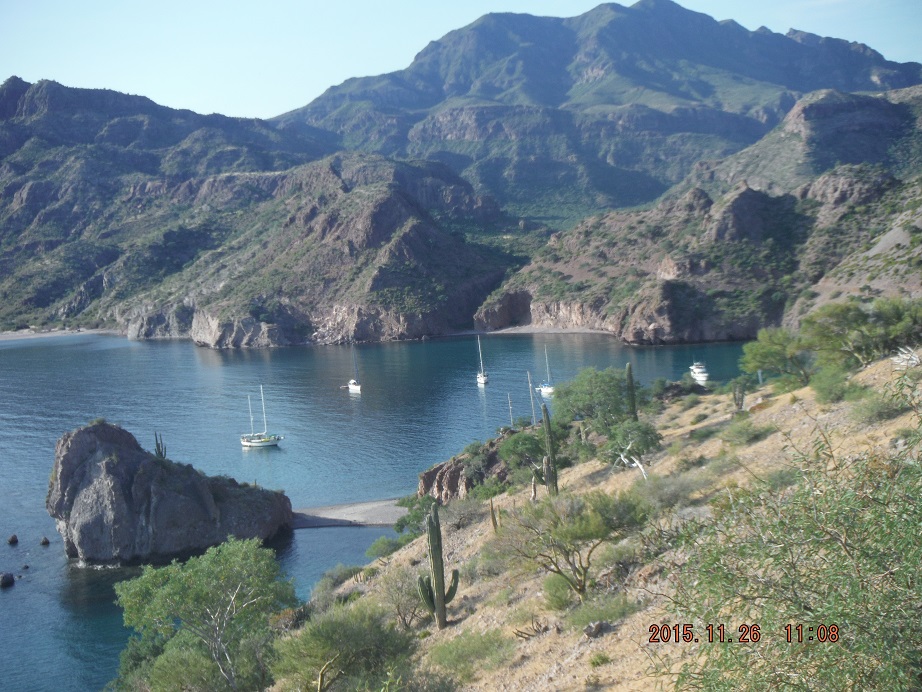
Agua Verde anchorage in the Sea of Cortez
We spent a great few days here, fishing, paddleboarding, kayaking, and enjoyed a beach fire with a bunch of other cruisers
and a crew game of baseball on the beach. From here south, to Ballandra, Loreto, Agua Verde, Escondido, San Jose and San Fransico islands.
Thanks to our dedicated team of spear and line fishermen we must have eaten freshly caught fish about 20 days out of 30. Trigger,
snapper, trevelly, mackerel, jack and a few other unknown species ended up on our table and we tried
a fair few different ways of preparing them. Ceviche (marinated in lime), grilled on the outdoor BBQ,
breaded and fried, cooked in a creamy bouillion, fish with coconut curry and rice; but a firm favourite was the humble
fish taco. Served with warm tortillas and fresh goats cheese from the local tienda, a crisp salad, and made-on-board
salsa, guacamole and our own boat-made yoghurt - fresh fish and some cold beer in a beautiful anchorage,
what more could we ask for?

Mahimahi caught by towing a line behind the sailing dinghy

Fred and his speared catch of the day
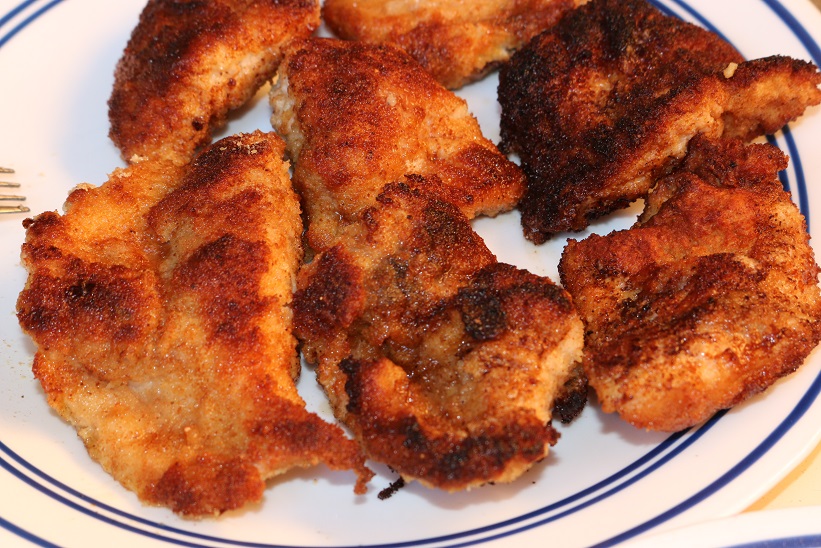
Breaded and fried and ready to go in the tacos

Beach fire in Espirutu Santo

Baked potatoes cooking on the fire
By December we were back in La Paz, and it was great to catch up with friends on Orion, Shearwater, Summer and Astraea.
We had a good group of us to watch the movie 'Heart of the Sea' which Frans had a role in, playing a sailor who
eventually gets killed by a giant whale. He had been
involved in building the whale boats for the movie, as well as working on the tall ship the 'Phoenix' which
was used as the 'Essex' in the movie. It was good to watch the completion of the movie that he had
been involved with, and especially in La Paz's luxury 'Platino' cinema - huge, fully reclining chairs, push
button waiter service, all for 40 pesos (less than 2 pounds!).
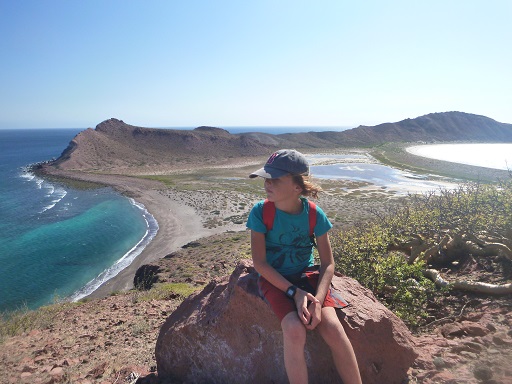
windy hike to the top of Isla San Francisco
We didn't linger long in La Paz this time, as we had plans to meet with a bunch of other family boats in La Cruz on the mainland.
The Christmas and New Year period was a whirlwind of socialising and activity. The boys loved to see so many of their friends again - on Pesto,
Enough, Coastal Drifter, Terrapin, Coaster, Sarita, Agamere and Wild Rumpus - and to make new ones, and a highlight was the kids beach camp where
they all slept out under the stars - no parents allowed! Us mums, dads and grandparents took to the town for a fun night of eating, drinking, and dancing.
We were all sad to leave La Cruz, and it was hard to say goodbye to good friends we knew we might not see again. That is the toughest part of this
lifestyle, and it doesn't get any easier the longer we do it.

Friends and crew before we left La Cruz
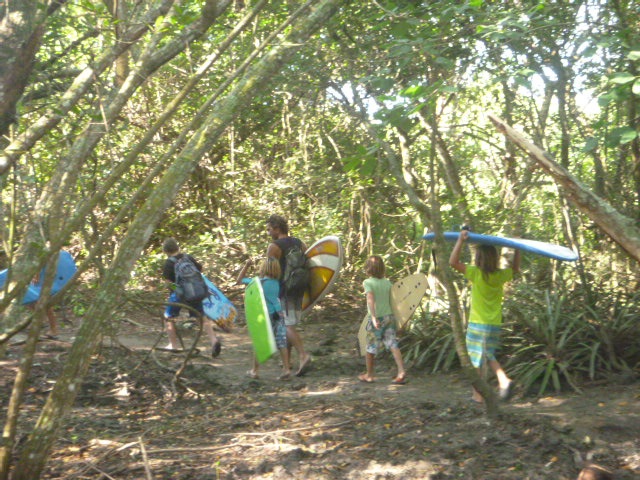
Taking the kids surfing on boxing day

Chcecking out Day of the Dead decorations in Guaymas
We hopped our way down Mexico's pacific coast, stopping in some charming anchorages and crossing the dreaded Golfo de Tehuantepec
in relative calm. Then onto Costa Rica! We had friends who were joining us there and a tight schedule to keep, so sadly could not stop
along the way, and sailed past Guatemala, El Salvador and Nicaragua. Another time I hope to come back over land and visit these countries.
So it was, during a Papagayo blow, that we found ourself reefed and battened down flying into the anchorage at Murcielago in Costa Rica, 3 weeks after
leaving La Cruz, and arriving on Frans' birthday just in time for me to bake a cake!
|